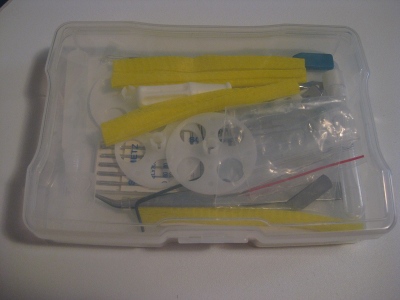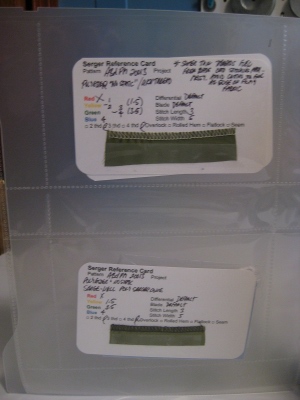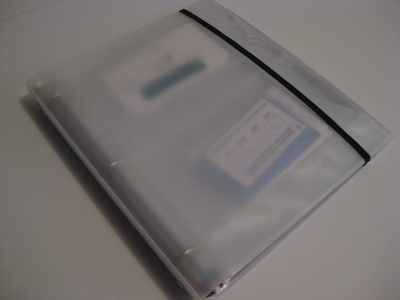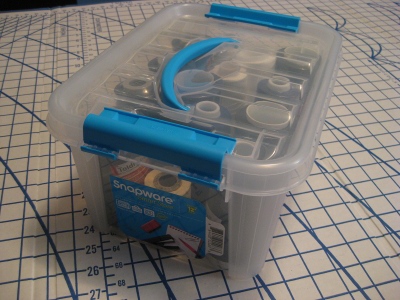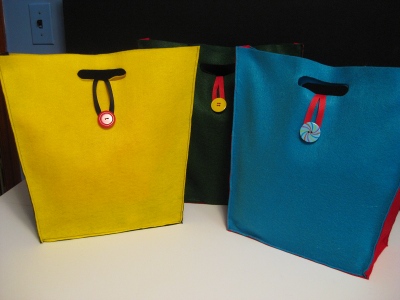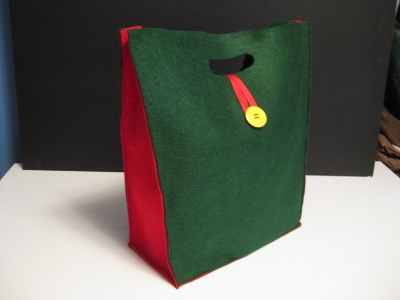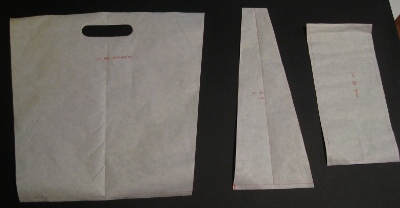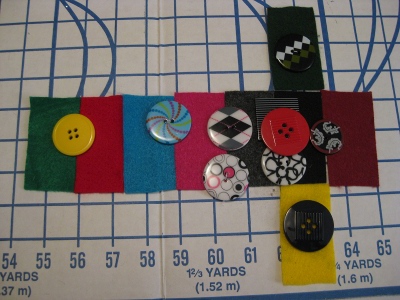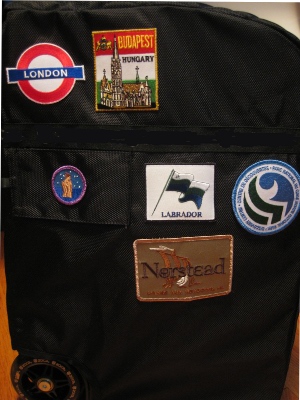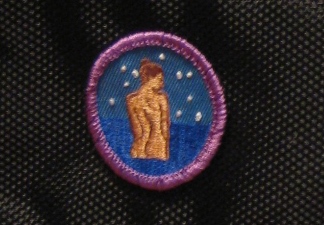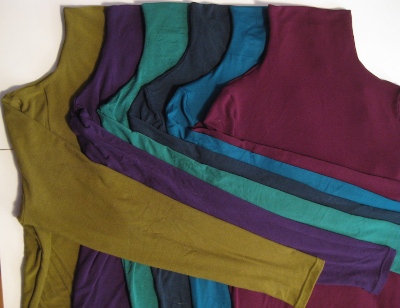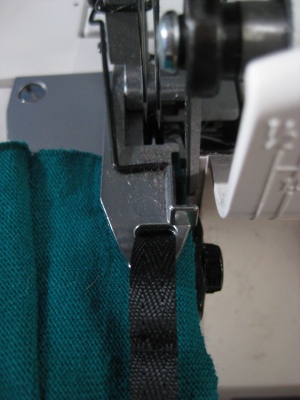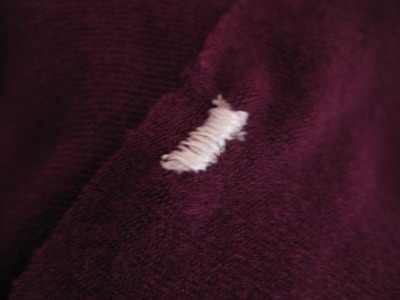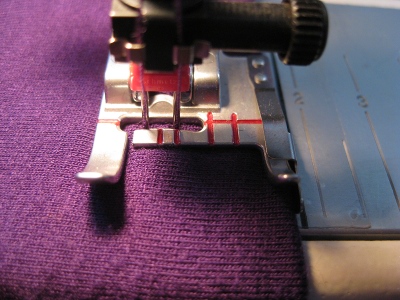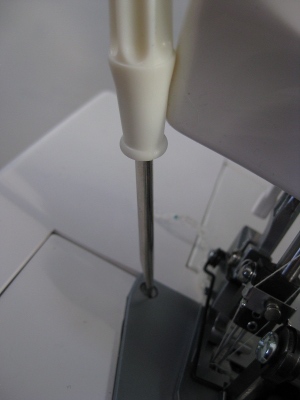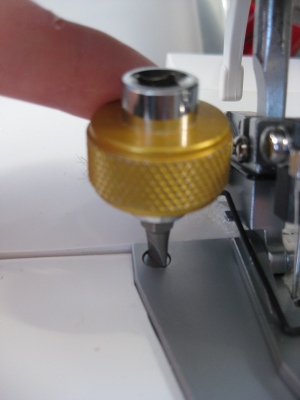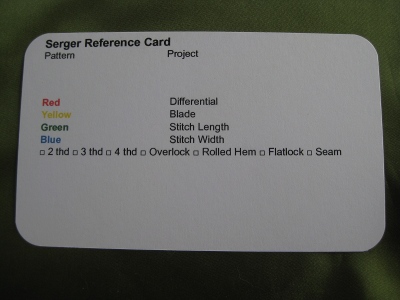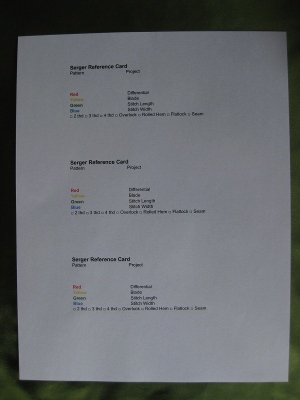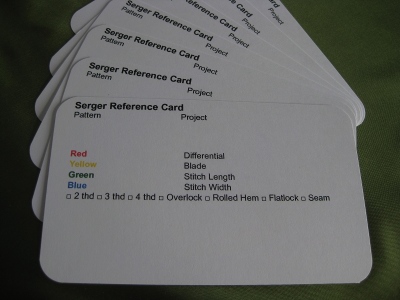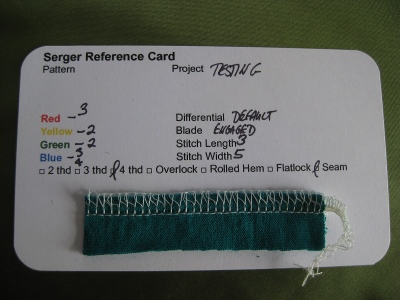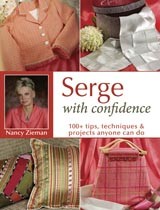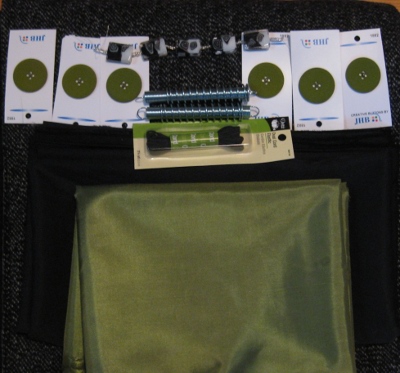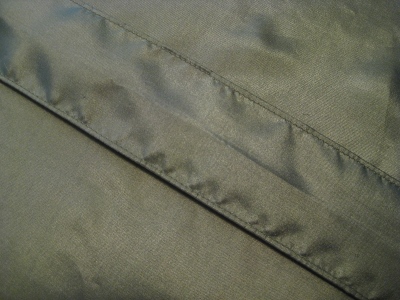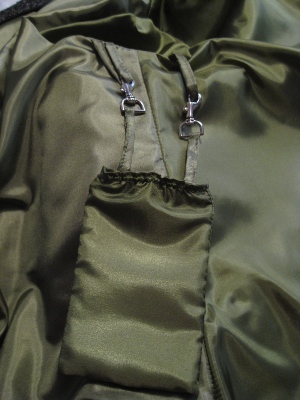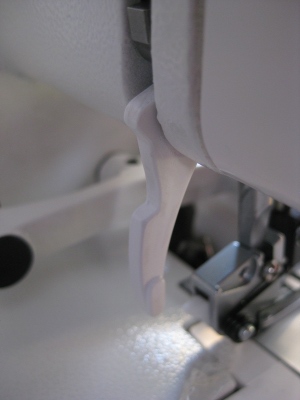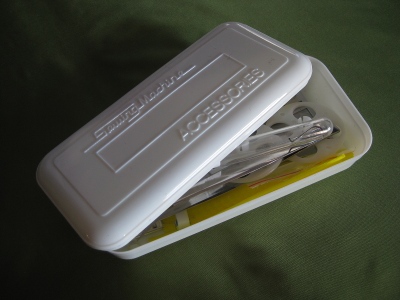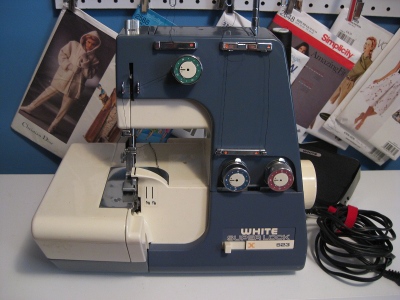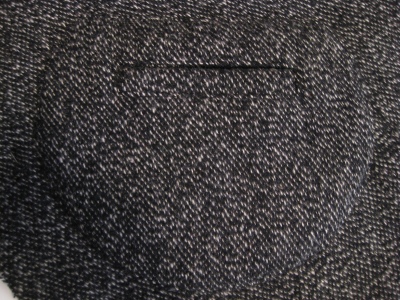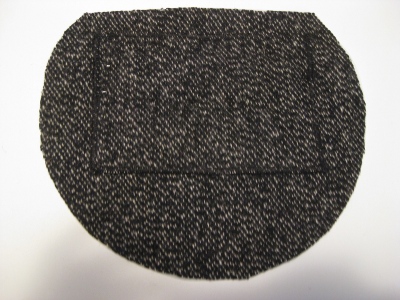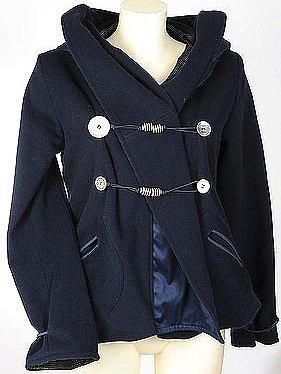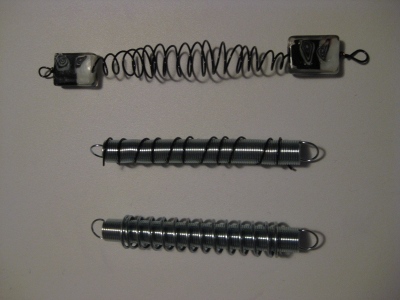This pattern, my first Au Bonheurs des Petites Mains, was all about experimentation, and it has been a wonderful experience all around. Not to mention that I love, love, love this jacket!
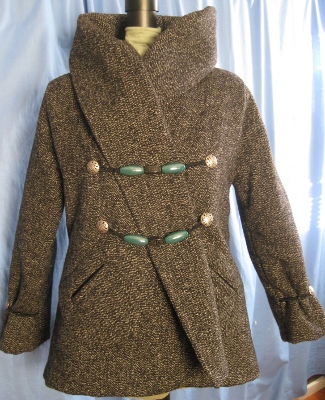
The lower fastener is drooping a bit; I didn’t catch it when I took the photo. This is probably due to the fact that the dummy isn’t fully dressed beneath the coat. It doesn’t seem to do this on me; if it did, of course, it would be an easy matter to tighten up the elastic.
The first part of the experiment was translating the directions from the original French, an effort that was not wholly successful. Then I changed some things that may or not have been addressed by the instructions (it was hard to tell).
There were all kinds of fun challenges along the way, every one of which was even more interesting because constructing this pattern involved thinking that was so different from my usual methods and approaches. Now that it’s finished, I’m still not sure exactly how it’s meant to be made!
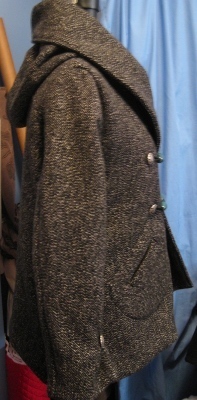
I think, for example, that this jacket is meant to have elastic strung through the hem, giving it a slight “bubble” effect. I didn’t do this; I think this makes my jacket longer than ABdPM’s, a length I prefer. Skipping this step also gives my jacket an A-line shape, kind of like an abbreviated “swing” jacket, which I like very much.
Choosing the closures was a whole adventure of its own. In the end, I strung ceramic beads on oval elastic. Loops on each end go around filigreed metal buttons:
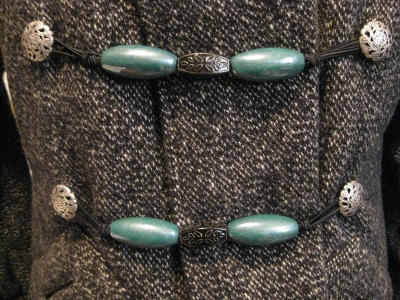
So that I don’t lose them, these fasteners are attached on one side, under the buttons.
The cuffs are caught up by elastic that loops over slightly smaller buttons:
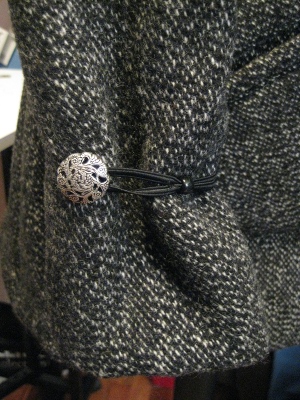
I love the curve of the yoke on the back, and the big, wacky hood:

The hood is wonderfully, insanely, bizarely huge:

It’s kind of Grim Reaper, isn’t it? But you wouldn’t wear it this way, of course. To wear it, you’d turn the front half of the hood back, which works perfectly, and is necessary if you expect to see where you’re going. Amazingly, the back part of the hood fits my head perfectly, and it stays in place very nicely even in a brisk wind.
This is a faux facing that I added so that I’d have a firm anchor for the chain, and a showcase for the ABdPM label:
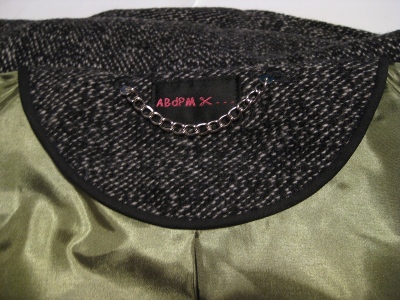
The vertical line below the facing is the pleat I added to the lining. It’s sewn closed under the facing, and below the waist to the hem. Did you note the label?

One comes with every pattern — it’s a superb finishing touch!
Here’s the comprehensive list of what I changed:
- did not use contrast for hood and front bands
- lengthened jacket by about an inch; did not elasticize hem which probably made for another inch or two increase
- made my own lining pattern; added center pleat for wearing ease; cut back lining all-in-one instead of separate yoke piece
- made welt pockets instead of using welt-trimming on each pocket edge
- added loops for hidden security pockets
The elastic closures on this jacket mean that it will always shift a bit in wearing, as you can see here:
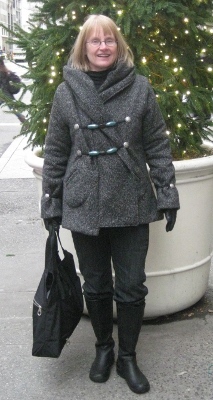
This jacket is really easy to wear, and the shifting doesn’t bother me a bit; it’s just part of how “free” this coat feels. However, it would be simple to add a button or two on the inside, or to replace the elastic cords with, say, flaps and toggles, if that’s what you preferred. That would make the coat look much more conventional, but it would keep the front in place.
Aside from the closure and the hood, there is one other unusual thing about this jacket. The wide front bands are not at the center of the jacket. Instead, they overlap each other completely; the seams where the bands join the front of the jacket are actually right at the center front, so there’s a double (really quadruple) layer down the front. Very nice in cold weather!
Although he likes this coat, Mr. Noile says that the elastic toggle on the top of the hood looks silly. And it does, when it’s sticking up straight. You can’t really see that here (or even the toggle itself, but I’m a little burnt out on photos here), but here’s how the hood looks in back when the elastic is drawn up:
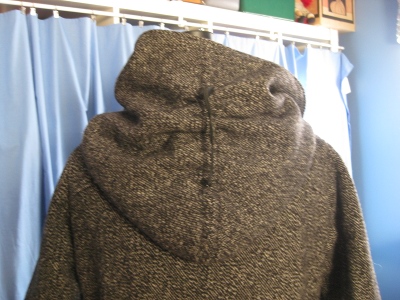
It would be easy enough to put the toggle at the other end of the elastic, near the curve of the hood if you preferred. I don’t mind it all at all — it is covered by the fold when the hood is up, and is unobtrusive when the hood’s down.
The pattern itself is well-drafted, although there was a minor issue at the front center neck, easily seen and resolved before cutting. I didn’t care for the “use the exterior pattern pieces for the lining” instructions, so I made my own lining pattern, which was easy enough to do.
Then there’s this curious anomaly: ABdPM calls for a contrast fabric for the hood/bands. I skipped this, because if I’d used their pattern piece, the outside of the hood would have been in this contrast fabric. But look at the ABdPM photograph:
 You can hardly see it, but under that top fastener is a seam. A seam that would have allowed using the contrast as a simple lining for the front band only, not for a one-piece band-and-hood. Hmmmm. Looks as if a little something got left on the drawing board. It would be easy enough to alter the pattern to allow this small change, and much nicer than having the contrast as the exterior of the hood. I can’t find any reference to this seam in the printed pattern, but that could be a language issue.
You can hardly see it, but under that top fastener is a seam. A seam that would have allowed using the contrast as a simple lining for the front band only, not for a one-piece band-and-hood. Hmmmm. Looks as if a little something got left on the drawing board. It would be easy enough to alter the pattern to allow this small change, and much nicer than having the contrast as the exterior of the hood. I can’t find any reference to this seam in the printed pattern, but that could be a language issue.
I had two minor problems while making this: One was inserting the elastic into the hood, which was due, at least in part, to the thickness of my fabric, but might have been easier if I’d fully understood the French directions.
The second had to do with the hood/front band pieces: When I lengthened the body of the jacket, I lengthened the band as well, but something went wrong, and the band ended up an inch shorter than the body. Here’s the bottom of the bands, with the lower edges of the fronts lined up. (The band’s the fuzzy part.):
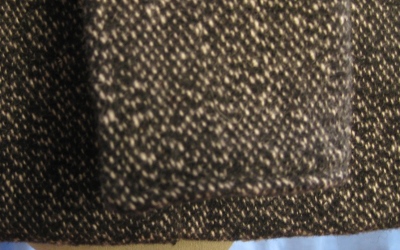
I could have fixed this by simply shortening the jacket, but, as it is, I’d probably make the next one two inches longer than this one. It would be more flattering, for example, if the hem didn’t hit right at the widest part of my hips, so shortening was not an option. Instead, I just left it as it was. I don’t think it materially harms the appearance of the jacket, and I would have been very unhappy with it shorter. Was the problem with my math? Was it because the body was supposed to have a wider elastic casing? Or is it an ABdPM error? I think my math was fine (it was easy math, after all!), but I’m not sure what happened here.
Bottom line: An experienced sewer will have no trouble with this pattern, but may have to work a little harder than usual to get through the project (unless fluent in sewing French). But it’s so worth it: As Mr. Noile said “It really looks French!”. I think so, too.
You won’t see another one of these on the streets of New York — unless someone reading this gets cracking! And please do — I could see this jacket made so many different ways. In cotton twill, for example, and unlined. In two shades of light linen, or a coordinating print and solid in a light linen. What about pinwale corduroy? Or canvas? Or in solid wools, say fuchsia and a purple for the contrast version that I didn’t make? Oooh-la-la!
Related:
Anticipation
ABdPM 20013: Fit and Interlining
ABdPM 20013: The Hood
ABdPM 20013: Miscellaneous Report
ABdPM 20013: The Lining
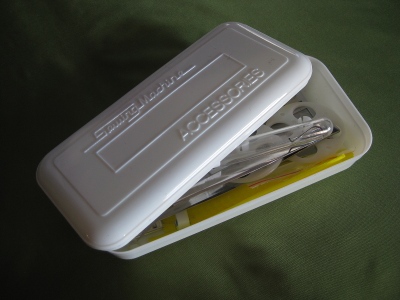 I’ve replaced it with a plastic box meant for photo storage:
I’ve replaced it with a plastic box meant for photo storage: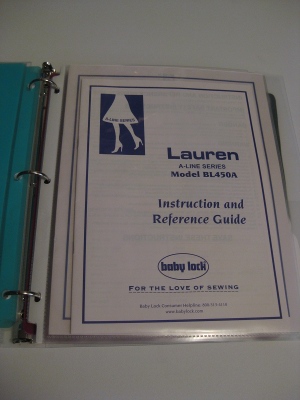 and so is the instruction disc that came with it
and so is the instruction disc that came with it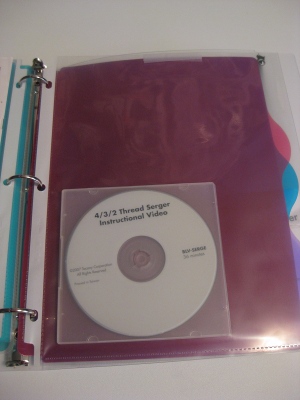 I added plastic dividers for the various sections; they give some needed support to the floppy pages.
I added plastic dividers for the various sections; they give some needed support to the floppy pages.
